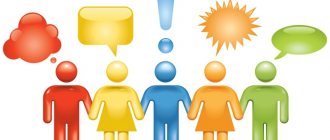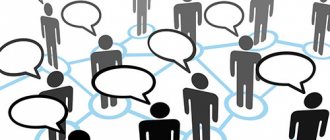Nonverbal is “body language” in a broad sense: the transmission of information through gestures, smells, taste, voice, visual signals. Nonverbal means of communication contribute to the creation of psychological contact between partners, enrich the meanings conveyed by words, and reflect the interpretation of the situation. Factors influencing the non-verbal side of communication are national characteristics, health status, professional etiquette, social status, and membership in certain age groups.
Means of nonverbal communication
Concept of nonverbal communication
There are two problems with understanding nonverbal communication:
Read also: Creating a bootable USB flash drive with MS-DOS
- firstly, with linguistic and speech communication, the process of transmitting and receiving information is realized by both parties, while with non-verbal communication it is carried out at unconscious or subconscious levels - this introduces some complications in understanding this phenomenon and raises the question of the justification of using the concept of “communication”. Therefore, some consider it acceptable to use, when it comes to nonverbal communication, another concept, “nonverbal behavior,” understanding it as the behavior of an individual that carries certain information, regardless of whether the individual is aware of it or not;
- secondly, in many scientific works there is confusion in the concepts of “nonverbal communication”, “nonverbal communication”, “nonverbal behavior”, most often used as synonyms. However, it is important to separate these concepts and clarify the context. According to the definition proposed by V. A. Labunskaya, “nonverbal communication is a type of communication that is characterized by the use of nonverbal behavior and nonverbal communication as the main means of transmitting information, organizing interaction, forming an image and concept of a partner, and exercising influence on another person." Therefore, the concept of “nonverbal communication” is broader than the concept of “nonverbal communication”.
The importance of nonverbal means in communication
Nonverbal communication includes 5 subsystems:
- Expressive (facial expressions, gestures, posture);
- Optical-kinetic (movement, appearance, facial expression);
- Tactile contact (handshake, pat, touch, kiss, hug);
- Extralinguistic (tempo, timbre of speech, pauses, intonation);
- Spatial (distance between interlocutors, personal space).
Finished works on a similar topic
Course work The role of nonverbal communication in communication 440 ₽ Abstract The role of nonverbal communication in communication 270 ₽ Test work The role of nonverbal communication in communication 220 ₽
Receive completed work or specialist advice on your educational project Find out the cost
In communication, the facial expression is very important, expressing the emotional state of the interlocutors during communication.
Definition 2
Facial expressions are the external expression of mental states, manifested in the coordination of facial muscle movements.
Movements of the facial muscles, their combination allows you to express the emotional state and understand the state of your interlocutor.
With the help of gestures, a person activates feedback, increases its intensity, or ends communication. An important component of nonverbal communication is also the gaze - with the help of visual contact, accurate signals of interpersonal communication are transmitted. The direction of the interlocutor's gaze indicates the direction of his attention and gives feedback. Undoubtedly, timbre, tempo of speech, inclusion of pauses in speech, and changes in intonation are important.
In interpersonal communication, it is necessary to take into account the totality of non-verbal means for the correct interpretation of communications, as well as the surrounding environment.
Psychologists believe that nonverbalism is an important condition for effective communication, because:
- non-verbal means allow you to understand the true feelings and thoughts of your interlocutor;
- impression of the interlocutor, formed under the influence of the first impression.
Microexpressions and involuntary nonverbal cues
Involuntary nonverbal behavior is those contractions of the muscles of the body and face that a person is unable to control.
Consciously telling a lie, trying to hide feelings, a person is nevertheless unable to control the so-called micro-expressions flashing on the face. These are tools of non-verbal behavior that help a specialist psychologist or simply a very observant interlocutor to recognize deception, an attempt to hide information or emotions, since it is impossible to consciously keep muscles from contracting such muscles.
Representatives of certain professions, for which the ability to recognize deception is very important, are taught this ability, or they look for people who are initially predisposed to reading microexpressions. Thus, the ability to detect a lie is extremely important for customs officials, security services, and investigators.
The Origin of Nonverbal Communication
Perception - what is it in psychology?
Non-verbal language has two types of source of origin: biological evolution and culture. Biologists have found that facial expressions when expressing emotions, most gestures and body movements in people are innate and serve as a signal for feedback.
- paleness or redness;
- enlarged pupils;
- curvature of the lips;
- blinking.
Based on intentional and unintentional communication, there are 3 nonverbal means of communication:
Read also: How to make a husband respect his wife
- Behavioral factors. Caused by a physiological reaction: sweating from excitement, trembling in case of cold or fear.
- Unintentional means. Associated with people's habits (scratching temples, swinging legs, biting lips).
- Communication signals. Conveys brief information about an object, event, or state.
The history of the emergence of nonverbal means of communication
Nonverbal behavior as a set of gestural and figurative expressions through the body arose at the dawn of humanity, when language as a means of communication had not yet been invented, and communication between individual representatives of the tribe was carried out precisely through nonverbal behavior.
It was possible to convey information through primitive gestures, and non-verbal means of communication coped with the task that ancient people needed to solve perfectly. They pointed to prey and fellow tribesmen with their hands, depicted simple phenomena - rain, thunderstorms, mimicked anger, threatened, grinning and baring their teeth.
An excellent example of primitive nonverbal behavior is the communication of dogs. Dogs almost never bark when meeting - they communicate by changing their gait, posture, level of tail movement, grinning or lowering their ears, and the information they receive is enough for them to correctly assess the situation and the status of their interlocutor.
Factors influencing nonverbal communication
It is advisable to interpret non-verbal means in a complex, since individually there is a risk of erroneous interpretation of the interlocutor’s behavior. For example, good-natured people may behave aggressively in self-defense because they once had a negative experience. However, there is also the opposite situation, when aggressive people can try on a mask of good nature, misleading others.
Certain circumstances influence the formation of body language:
- Age of the person;
- Nationality;
- Level of education;
- Temperament, character;
- Social status;
- Features of the profession;
- Mood;
- Artistic talent;
- Ability to use non-verbal means of communication.
There is no single system for assessing body language, but some elements are universal and are interpreted by people unambiguously.
Nonverbal and verbal means of communication
Communicative interaction or communication is a rather complex multifaceted process of first establishing and then developing contacts between individuals, caused by the need for joint activities and covering the exchange of messages, the development of a general direction or strategy of interaction and perception with subsequent understanding of another subject. Communication interaction consists of three components:
- Communicative, representing the direct exchange of information between communicating people;
- Interactive, which consists in organizing interaction between subjects;
- Perceptual, consisting in the process of individuals perceiving each other and establishing mutual understanding.
Communicative interaction can be verbal and non-verbal. In the process of everyday life, individuals talk with many people, using both verbal and non-verbal language. Speech helps people share knowledge, worldviews, make acquaintances, establish social contacts, etc. However, without the use of non-verbal and verbal means of communication, speech will be difficult to understand.
Features of nonverbal communication and verbal interaction consist in the use of various tools for accepting and analyzing incoming data during communications. Thus, people use intelligence and logic to perceive information conveyed by words, and they use intuition to understand nonverbal communication.
Verbal communication implies an understanding of exactly how speech is perceived by a communication partner and what impact it has on him. After all, speech is one of the fundamental means of interpersonal communication.
Nonverbal communication and its means
Nonverbal means of communication are classified according to the use of different channels: auditory, visual, gustatory, olfactory and tactile senses. The typology divides them into the main types of nonverbal communication, which are characterized by their own means.
The acoustic system of nonverbal behavior.
For the acoustic system of nonverbal communication, nature has provided for the use of the opponent's hearing and the perception of sound vibrations by him. In this case, the speech component of communication is not used. The acoustic system includes the following types of communication:
- Pauses. Pause is an integral part of speech. Nonverbal communication uses it to improve understanding of speech's meaning by emphasizing aspects of what has been said before. During a conversation, it is important to be able to use short-term silence, which will allow you to focus attention on the statement and give the opponent the right to speak out.
- Sigh. Laughter. Cry. Cough. These means are used to express states and emotions. For example: excitement, joy, resentment or doubt.
Optical system of nonverbal behavior
Kinesics is an optical channel of perception. Communication occurs through eye contact between interlocutors and the transmission of information through the organs of vision. The internal state of a person is described by gestures, posture and facial expressions. Optical system typology:
- Facial expressions. Facial expressions are complex movements of facial muscles. This occurs naturally under the influence of a person’s emotional state, but sometimes it can be intensified specifically to make the words dramatic.
- Gestures. These are manifestations of the human condition, demonstrating the intensity of experiences. With emotional overexcitation, the number of different involuntary movements of the arms and legs increases. Gestures are divided into spontaneous and artificial. The first ones express emotions. Artificial gestures are sometimes called professional, since they are mastered by people of different specific specialties. For example: the movement of the conductor’s hand, the “language of the deaf and dumb,” the gestures of sailors.
- Pose. The presentation of body position characterizes the state of a person’s psyche. The head, body and limbs are simultaneously subject to coordinated movements. Moreover, the person takes the pose for a long time, occasionally correcting it. People who are confused, embarrassed or offended take a closed posture. Subconsciously, it helps a person to protect himself and hide from factors that cause negative feelings. An open posture occurs in a person with an optimistic attitude and a cheerful mood.
- Gait. Gait is the habitual style and way of walking. Tightness or, conversely, openness greatly changes the gait. A confident, energetic gait indicates a person with adequate self-esteem. And a squeezed hobbling passer-by will probably turn out to be complex and unsure of himself.
- Eye contact. During a conversation, eye contact is maintained between people. Thus, the ability to make eye contact is the main skill required for various situations in social life. Eyes allow a person to receive knowledge from 5 sources at once:
- Change in eye shape due to muscle contraction. Determination of changes in the appearance of the eye, its structure, shape and facial expression that creates an idea of a person.
- Direction of view. People look away when they experience certain emotions. For example: the gaze is directed downwards due to resentment, grief or shame.
- Blinking. This process becomes more intense with tension and excessive worry. Nonverbal communication allows you to notice this.
- Pupil size. When excited, the pupils dilate. This happens regardless of the desire and will of a person. The contraction and dilation of the pupils is regulated by the human autonomic nervous system.
- Tears. Sometimes they are also classified as a function of the autonomic nervous system. However, some people have a skill for artificially inducing tears.
- Physiognomy. Physiognomy is a method for determining a person’s personality type, the state of his physical, mental health and spiritual qualities. Identification occurs through the analysis of features, the concept of features of appearance and facial expression. The nature of the appearance of physiognomy is still not known for certain, but scientists from all over the world prove or disprove the dependence of a person’s character on the type of his face. Physiognomy includes the following forms:
- Ethnological. The relationship between a person’s appearance and the time of year and the environment.
- Geometric. The main facial types are divided into 5 types and 15 classes. Each of them has their own character traits.
- Mimic. Physiognomic signs are external expressions of feelings. Gestures and facial expressions indicate the corresponding personality type.
- Astrological. Prescribes the connection between facial features and celestial bodies.
Tactile-kinetic system of nonverbal behavior
Takeshika is the name given to communicative communication through tactile sensations.
- Handshake. People shaking each other's hands is a kind of gesture used at the moment of greeting or farewell. A handshake expresses a person’s goodwill and openness to further communication. Refusal to shake hands is considered a sign of hostility and aggression.
- Kiss. This concept covers the family and society as a whole. A kiss expresses a sincere feeling of love and affection between people. It arises between lovers. This kind of kiss is called romantic, it is tender and reverent, and sometimes passionate. A kiss between friends, friends or relatives expresses sympathy and friendliness.
- Stroking. Stroking gives a person a pleasant sensation. Therefore, people who give strokes to loved ones express love and care in this way.
- Pat. This is a gesture that shows approval or support.
Olfactory system of nonverbal behavior
The olfactory system is based on the human sense of smell. All surrounding odors are analyzed.
The olfactory system includes:
- Body odor. The identification of smell serves as an indicator of an individual's image. Nature itself took care of this. The concept of a person is formed based on the characteristics of his body odor. Thanks to our natural sense of smell, people manage to live a social life much easier.
- The smell of perfume or cosmetics. This aspect concerns exclusively the female gender. Based on the chosen aroma, the concept of a woman’s taste, mood and even material wealth appears.
The Importance of Nonverbal Communication
Nonverbal communication is an important addition to basic communication, allowing you to convey much more information to your interlocutor, increase the level of mutual understanding and make any conversation more constructive. Psychologists call 5 main functions of nonverbal signals:
- Duplication. With a gesture, facial expression or intonation, a person can repeat the main message, confirming it, making it more understandable and unambiguous.
- Contradiction. Consciously or unconsciously, a person may show that he meant the opposite. For example, when talking about his intentions, he can wink conspiratorially.
- Substitution of meaning. With your eyes and facial expressions you can not only complement the meaning, but also completely change it or demonstrate that the phrase is said in a figurative meaning.
- Addition to what was said. Certain gestures can convey additional messages. For example, a person can say that he does not want to do something, but show by his facial expression that he is tired of it.
- Strengthening meaning. Kind words can be emphasized with a friendly smile, and an emotional statement can be emphasized by hitting the table with your fist.
Nonverbal communication and its types
Nonverbal communication is divided into types. The typology is related to the fact that, having an understanding of iconic forms of communication and their types, it is much easier to understand yourself and the people around you.
Sign communications are divided into types:
- Kinesics. This includes gestures, body movements and postures. Their role is to complement different means of communication. For the nonverbal communication system, postures, gestures, facial expressions and gaze are important - the main kinesic elements.
- Sensory - sensory perception using the tactile organs.
- Chronemics. It involves the use of time in nonverbal communication.
- Proxemics. It is based on the use of interpersonal relationships. It is divided into the following types:
- Personal.
- Intimate.
- Public.
- Social.
Basic elements of nonverbal communication
Learning nonverbal communication will make our everyday communication more effective. The ability to read between the lines is very important in the process of building a behavioral strategy, since various manifestations of non-verbal exchange of information can be the key to many mysteries and secrets. It is believed that not a single person is able to completely control the movements of facial expressions and gestures during a conversation. Even weak signals instinctively given by the interlocutor will help his opponent draw the right conclusions.
- Behavior
: By observing changes in a person's behavior depending on the situation, a lot of useful information can be gleaned.
Expression
– expressive means: gestures, facial expressions.
Tactile interaction
: touching, shaking hands, hugging, patting on the back.
Gaze
: duration, direction, change in pupil size.
Movement in space
: gait, posture while sitting, standing, etc.
Individual reactions to various events
: speed of movements, their nature (sharp or smooth), completeness, etc.
Modern scientists have nevertheless been able to develop special techniques that make it possible to mislead even sign language experts. Having thoroughly studied some non-verbal techniques, you can use certain elements to convince the interlocutor of the sincerity of your intentions. But this is quite difficult, since non-verbal accompaniment of speech is activated during dialogue by our subconscious.
Eye contact
Eyes can also be used to express a wide range of human feelings and emotions. For example, eye contact can mean the beginning of a conversation, during a conversation it is a sign of attention, support or, conversely, termination of communication, it can also indicate the end of a remark or a conversation as a whole. In conversation, people often look into each other's eyes because the eyes are what most draw our attention to the speaker's face. They not only occupy a central place in the field of vision, but are also able to most accurately convey the true emotional state of a person. It is not for nothing that many consider the eyes to be the mirror of the soul, and their movements indicate the course of thoughts. Conventionally, the following types of appearance can be distinguished: business, secular, everyday, friendly, intimate and final.
A business look is usually directed at a conventional triangle formed by the interlocutor’s eyes and mouth. Sometimes it is directed to the center of the forehead and does not go below the eyes. It is used in conversation and negotiation and indicates the formality or formality of the relationship between communicating partners, who usually sit opposite each other. Social gaze covers the area of the face, neck and chest and is used when communicating in small groups of up to 20 people. Most often it can be found at various meetings, presentations, press conferences and business meetings. The social look is the same as the business look, but it is much softer and more attractive in appearance. It is used for small talk, guests or receptions. A friendly look is characterized by the fact that the eyes of the person to whom it belongs move within the triangle formed by the eyes of the interlocutor and the center of his chest. Usually it is typical for people who are in an informal relationship with a partner, and indicates the presence of a certain spiritual closeness to the person to whom it is addressed. An intimate gaze usually does not have a constant direction; it moves and slides vertically. Most often it is observed in informal interpersonal relationships between people of the opposite sex. In one-on-one conversations, in situations where one of the interlocutors wants to show the other that he wants to quickly end the conversation for negative reasons, the so-called closing gaze is used. Usually it is directed to the center of the partner's forehead and does not move anywhere.
Features of the interlocutor's gaze are the direction of gaze, frequency of blinking, pupil size, eyelid position, visibility of the corner of the eye, duration of concentration, shine and opening. Depending on the direction, there are the following types of gaze: straight, past, through a partner, sideways, up, down, in breadth and upward. Direct gaze is an indicator of confidence and respect for a partner, as well as a desire to initiate or continue contact. Looking past your partner shows indifference to him and the egocentrism of the one who gives it. People who show clear disrespect for another person, and sometimes an aggressive attitude towards him, see right through their partner. A side glance is used when there is distrust, suspicion and skepticism towards the speaker. Looking up radiates a feeling of arrogance, superiority, or contempt for a particular person or event. The downward gaze is used in two cases - in a state of extreme anger, bordering on aggression ("frowning"), and in a state of humility and submission, expressed by bending the upper body and head forward. Looking into the distance during a conversation indicates the emergence of doubts, hesitations and mistrust on the part of the interlocutor. Such a look can also be a sign of a thoughtful attitude towards something important. This condition may correspond to looking up with the eyes slightly raised towards the forehead. When a person is busy raising a thought to express it, he usually looks away when the thought is ready for expression and looks at the interlocutor. It is noticeable that the speaker looks at the interlocutor less than the listener. The first one does this only to make sure that the partner's attention and interest is maintained, and the second one does this to provide feedback in the conversation.
There is an opinion that the interlocutor’s gaze during a conversation should meet the partner’s eyes for approximately 60-70% of the total duration of the conversation. It is known that sociable and sociable people look at their interlocutor more carefully and longer than withdrawn and closed people. We spend more time looking at those we admire and with whom we have close relationships. It has also been found that women look at their interlocutor longer than men; and if the interlocutor is a woman, then the duration of eye contact is longer. By the way, the latter is also typical for male speaking couples. Only men look longer at those they like, and women look longer at those they like. When communicating with businessmen, you should consider whether the topic under discussion is pleasant or unpleasant for one of the parties. Accordingly, a gaze directed at a person that is unpleasant or incomprehensible may be perceived as annoying. It should be remembered that most of us avoid eye contact during arguments and conflicts. This is especially true for women. It has been observed that the closer the interlocutors are during a conversation, the less they look at each other, and vice versa.











